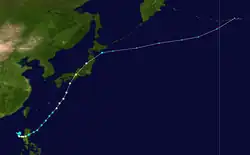Typhoon Vicki
Typhoon Vicki, known in the Philippines as Typhoon Gading, was a typhoon that was notable for having a strange eastward-northeastward track through the Philippines and Japan. The eleventh tropical depression, seventh named tropical storm and fourth typhoon of the inactive 1998 Pacific typhoon season, Vicki originated from an area of disturbed weather in the South China Sea.[1][2]
 Typhoon Vicki on September 22, 1998 | |
| Meteorological history | |
|---|---|
| Formed | September 17, 1998 |
| Dissipated | September 22, 1998 |
| Typhoon | |
| 10-minute sustained (JMA) | |
| Highest winds | 140 km/h (85 mph) |
| Lowest pressure | 960 hPa (mbar); 28.35 inHg |
| Category 2-equivalent typhoon | |
| 1-minute sustained (SSHWS/JTWC) | |
| Highest winds | 165 km/h (105 mph) |
| Overall effects | |
| Fatalities | 108 total |
| Damage | Unspecified |
| Areas affected | Philippines, Japan |
| IBTrACS | |
Part of the 1998 Pacific typhoon season | |
Meteorological history

Tropical storm (39–73 mph, 63–118 km/h)
Category 1 (74–95 mph, 119–153 km/h)
Category 2 (96–110 mph, 154–177 km/h)
Category 3 (111–129 mph, 178–208 km/h)
Category 4 (130–156 mph, 209–251 km/h)
Category 5 (≥157 mph, ≥252 km/h)
Unknown
On September 17, a tropical disturbance formed at South China Sea west of Luzon. It intensified quickly and was named Vicki, eventually attaining typhoon status a day after it formed. Unusual for a Pacific typhoon, the system moved eastward and crossed Luzon on September 18, bringing squally conditions to most parts of the island.[3][4] After that, Vicki then moved northeast, and eventually made landfall on September 22 at the Kii Peninsula in Japan.[5]
Impact
In all, 108 people were killed and 10 others were listed as missing. Damages from the storm amounted to $1.86 billion.
Philippines
- 100 mph (160 km/h) Typhoon Vicki, while moving eastward through northern Luzon, dropped torrential rainfall, killing 9 people and affecting more than 300,000 people. The ferry MV Princess of the Orient sank during the storm's onslaught, killing 70 and leaving 80 others missing and presumed dead.[6] The ferry sank near Fortune Island in the Verde Island Passage.[6]
Japan
- Vicki continued northeastward and hit southern Japan killing two women in Nara prefecture, damaging Kasuga Grand Shrine in Nara city and the five-storied pagoda at Muro temple, disrupting train and passenger service and cancelling over 60 domestic flights in the country.[5]
See also
- Tropical cyclones in 1998
- Tropical Storm Linfa (2003) – a strong tropical storm that nearly replicated Vicki's path 5 years later
- Tropical Storm Halong (2008) – another relatively strong storm which also took a similar trajectory to Vicki ten years later
- Typhoon Chan-hom (2009) – a typhoon that also moved eastward and made landfall in northern Luzon
References
- Extratropical Transformation of Typhoon Vicki (9807): Structural Change and the Role of Upper-tropospheric Disturbances
- "TYPHOON 2000 - Philippine Tropical Cyclones 1998 Season". www.typhoon2000.ph. Retrieved September 14, 2020.
- "デジタル台風:台風199807号 (VICKI) - 詳細経路情報(Google Maps版)". agora.ex.nii.ac.jp. Retrieved September 14, 2020.
- An Analysis of Typhoon 9807 (Vicki) Based on Surface Meteorological Records Obtained from Fire Stations
- "台風第8・7号 平成10年(1998年) 9月20日~9月23日". www.data.jma.go.jp. Retrieved September 14, 2020.
- ABS-CBN News (July 3, 2008). "Sulpicio loses court case on Princess of the Orient fatality". ABS-CBN News. Retrieved September 14, 2020.
